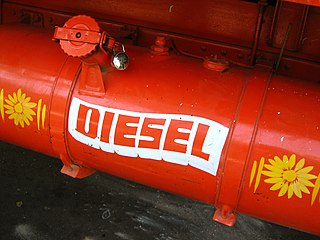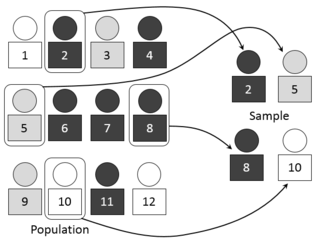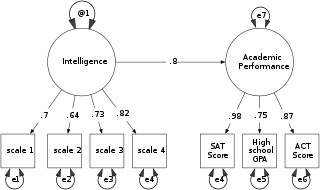
Generally speaking, diesel fuel, also called diesel oil, is any liquid fuel specifically designed for use in a diesel engine, a type of internal combustion engine in which fuel ignition takes place without a spark as a result of compression of the inlet air and then injection of fuel. Therefore, diesel fuel needs good compression ignition characteristics.
An octane rating, or octane number, is a standard measure of a fuel's ability to withstand compression in an internal combustion engine without detonating. The higher the octane number, the more compression the fuel can withstand before detonating. Octane rating does not relate directly to the power output or the energy content of the fuel per unit mass or volume, but simply indicates gasoline's capability against compression.

In statistics, quality assurance, and survey methodology, sampling is the selection of a subset of individuals from within a statistical population to estimate characteristics of the whole population. Statisticians attempt to collect samples that are representative of the population in question. Sampling has lower costs and faster data collection than measuring the entire population and can provide insights in cases where it is infeasible to measure an entire population.

Biodiesel is a form of diesel fuel derived from plants or animals and consisting of long-chain fatty acid esters. It is typically made by chemically reacting lipids such as animal fat (tallow), soybean oil, or some other vegetable oil with an alcohol, producing a methyl, ethyl or propyl ester by the process of transesterification.

Avgas is an aviation fuel used in aircraft with spark-ignited internal combustion engines. Avgas is distinguished from conventional gasoline (petrol) used in motor vehicles, which is termed mogas in an aviation context. Unlike motor gasoline, which has been formulated since the 1970s to allow the use of platinum-content catalytic converters for pollution reduction, the most commonly used grades of avgas still contain tetraethyllead (TEL), a toxic substance used to prevent engine knocking. There are ongoing experiments aimed at eventually reducing or eliminating the use of TEL in aviation gasoline.

Motor oil, engine oil, or engine lubricant is any one of various substances used for the lubrication of internal combustion engines. They typically consist of base oils enhanced with various additives, particularly antiwear additives, detergents, dispersants, and, for multi-grade oils, viscosity index improvers.. The main function of motor oil is to reduce friction and wear on moving parts and to clean the engine from sludge and varnish (detergents). It also neutralizes acids that originate from fuel and from oxidation of the lubricant (detergents), improves sealing of piston rings, and cools the engine by carrying heat away from moving parts.
Shell V-Power is the brand name given to Shell's enhanced high specification fuels for road motor vehicles including Shell V-Power Nitro+ and Shell V-Power Diesel. Introduced in Italy in 2001, Shell relaunched the fuel in March 2008, under the name Nitrogen-Enriched Shell V-Power, with nitrogen-containing detergents.
Cetane number is an indicator of the combustion speed of diesel fuel and compression needed for ignition. It plays a similar role for diesel as octane rating does for gasoline. The CN is an important factor in determining the quality of diesel fuel, but not the only one; other measurements of diesel fuel's quality include energy content, density, lubricity, cold-flow properties and sulphur content.

Hexadecane (also called cetane) is an alkane hydrocarbon with the chemical formula C16H34. Hexadecane consists of a chain of 16 carbon atoms, with three hydrogen atoms bonded to the two end carbon atoms, and two hydrogens bonded to each of the 14 other carbon atoms.

Jet fuel or aviation turbine fuel is a type of aviation fuel designed for use in aircraft powered by gas-turbine engines. It is colorless to straw-colored in appearance. The most commonly used fuels for commercial aviation are Jet A and Jet A-1, which are produced to a standardized international specification. The only other jet fuel commonly used in civilian turbine-engine powered aviation is Jet B, which is used for its enhanced cold-weather performance.

Structural equation modeling (SEM) is a label for a diverse set of methods used by scientists in both experimental and observational research across the sciences, business, and other fields. It is used most in the social and behavioral sciences. A definition of SEM is difficult without reference to highly technical language, but a good starting place is the name itself.
JP-8, or JP8 is a jet fuel, specified and used widely by the US military. It is specified by MIL-DTL-83133 and British Defence Standard 91-87, and similar to commercial aviation's Jet A-1, but with the addition of corrosion inhibitor and anti-icing additives.
Higher alkanes are alkanes having nine or more carbon atoms. Nonane is the lightest alkane to have a flash point above 25 °C, and is not classified as dangerously flammable.
The calculated carbon aromaticity index (CCAI) is an index of the ignition quality of residual fuel oil.
Tetranitromethane or TNM is an organic oxidizer with chemical formula C(NO2)4. Its chemical structure consists of four nitro groups attached to one carbon atom. In 1857 it was first synthesised by the reaction of sodium cyanoacetamide with nitric acid.
In statistics, confirmatory factor analysis (CFA) is a special form of factor analysis, most commonly used in social research. It is used to test whether measures of a construct are consistent with a researcher's understanding of the nature of that construct. As such, the objective of confirmatory factor analysis is to test whether the data fit a hypothesized measurement model. This hypothesized model is based on theory and/or previous analytic research. CFA was first developed by Jöreskog (1969) and has built upon and replaced older methods of analyzing construct validity such as the MTMM Matrix as described in Campbell & Fiske (1959).

Winter diesel fuel refers to diesel fuel enhanced to prevent it from gelling in cold weather conditions. In general it is achieved by treatment with additives that change the low temperature characteristics of the fuel.
A Cetane Improver [′sē‚tān im′prüv·ər] is a chemical which has the effect of increasing a diesel fuel's Cetane number. A few examples are nitrates, nitroalkanes, nitrocarbonates and peroxides.
Total Base Number (TBN) is a measurement of basicity that is expressed in terms of the number of milligrams of potassium hydroxide per gram of oil sample. TBN is an important measurement in petroleum products, and the value varies depending on its application. TBN generally ranges from 6–8 mg KOH/g in modern lubricants, 7–10 mg KOH/g for general internal combustion engine use and 10–15 mg KOH/g for diesel engine operations. TBN is typically higher for marine grade lubricants, approximately 15-80 mg KOH/g, as the higher TBN values are designed to increase the operating period under harsh operating conditions, before the lubricant requires replacement.








